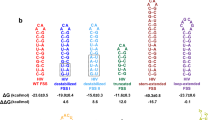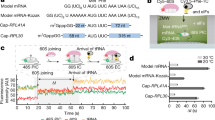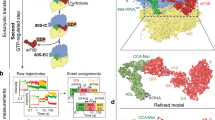Abstract
Efficient translation initiation and optimal stability of most eukaryotic messenger RNAs depends on the formation of a closed-loop structure and the resulting synergistic interplay between the 5′ m7G cap and the 3′ poly(A) tail1,2. Evidence of eIF4G and Pab1 interaction supports the notion of a closed-loop mRNP3, but the mechanistic events that lead to its formation and maintenance are still unknown. Here we use toeprinting and polysome profiling assays to delineate ribosome positioning at initiator AUG codons and ribosome–mRNA association, respectively, and find that two distinct stable (resistant to cap analogue) closed-loop structures are formed during initiation in yeast cell-free extracts. The integrity of both forms requires the mRNA cap and poly(A) tail, as well as eIF4E, eIF4G, Pab1 and eIF3, and is dependent on the length of both the mRNA and the poly(A) tail. Formation of the first structure requires the 48S ribosomal complex, whereas the second requires an 80S ribosome and the termination factors eRF3/Sup35 and eRF1/Sup45. The involvement of the termination factors is independent of a termination event.
This is a preview of subscription content, access via your institution
Access options
Subscribe to this journal
Receive 51 print issues and online access
$199.00 per year
only $3.90 per issue
Buy this article
- Purchase on Springer Link
- Instant access to full article PDF
Prices may be subject to local taxes which are calculated during checkout




Similar content being viewed by others
References
Jacobson, A. in Translational Control (eds Hershey, J. W., Mathews, M. B. & Sonenberg, N.) 451–480 (Cold Spring Harbor Laboratory Press, Cold Spring Harbor, NY, 1996)
Gallie, D. R. The cap and poly(A) tail function synergistically to regulate mRNA translational efficiency. Genes Dev. 5, 2108–2116 (1991)
Wells, S. E., Hillner, P. E., Vale, R. D. & Sachs, A. B. Circularization of mRNA by eukaryotic translation initiation factors. Mol. Cell 2, 135–140 (1998)
Dmitriev, S. E., Pisarev, A. V., Rubtsova, M. P., Dunaevsky, Y. E. & Shatsky, I. N. Conversion of 48S translation preinitiation complexes into 80S initiation complexes as revealed by toeprinting. FEBS Lett. 533, 99–104 (2003)
Amrani, N. et al. A faux 3′-UTR promotes aberrant termination and triggers nonsense-mediated mRNA decay. Nature 432, 112–118 (2004)
Wu, C., Amrani, N., Jacobson, A. & Sachs, M. S. The use of fungal in vitro systems for studying translational regulation. Methods Enzymol. 429, 203–225 (2007)
Tarun, S. Z. & Sachs, A. B. A common function for mRNA 5′ and 3′ ends in translation initiation in yeast. Genes Dev. 9, 2997–3007 (1995)
De Gregorio, E., Preiss, T. & Hentze, M. W. Translational activation of uncapped mRNAs by the central part of human eIF4G is 5′ end-dependent. RNA 4, 828–836 (1998)
Sachs, A. in Translational Control of Gene Expression (eds Sonenberg, N., Hershey, J. W. & Mathews, M. B.) 447–465 (Cold Spring Harbor Laboratory Press, Cold Spring Harbor, NY, 2000)
Karim, M. M. et al. A mechanism of translational repression by competition of Paip2 with eIF4G for poly(A) binding protein (PABP) binding. Proc. Natl Acad. Sci. USA 103, 9494–9499 (2006)
Christensen, A. K., Kahn, L. E. & Bourne, C. M. Circular polysomes predominate on the rough endoplasmic reticulum of somatotropes and mammotropes in the rat anterior pituitary. Am. J. Anat. 178, 1–10 (1987)
Baer, B. W. & Kornberg, R. D. The protein responsible for the repeating structure of cytoplasmic poly(A)-ribonucleoprotein. J. Cell Biol. 96, 717–721 (1983)
Sachs, A. B., Bond, M. W. & Kornberg, R. D. A single gene from yeast for both nuclear and cytoplasmic polyadenylate-binding proteins: domain structure and expression. Cell 45, 827–835 (1986)
Sachs, A. B., Davis, R. W. & Kornberg, R. D. A single domain of yeast poly(A)-binding protein is necessary and sufficient for RNA binding and cell viability. Mol. Cell. Biol. 7, 3268–3276 (1987)
Gebauer, F., Corona, D. F., Preiss, T., Becker, P. B. & Hentze, M. W. Translational control of dosage compensation in Drosophila by Sex-lethal: cooperative silencing via the 5′ and 3′ UTRs of msl-2 mRNA is independent of the poly(A) tail. EMBO J. 18, 6146–6154 (1999)
Munroe, D. & Jacobson, A. mRNA poly(A) tail, a 3′ enhancer of translational initiation. Mol. Cell. Biol. 10, 3441–3455 (1990)
Otero, L. J., Ashe, M. P. & Sachs, A. B. The yeast poly(A)-binding protein Pab1p stimulates in vitro poly(A)-dependent and cap-dependent translation by distinct mechanisms. EMBO J. 18, 3153–3163 (1999)
Goyer, C. et al. TIF4631 and TIF4632: two yeast genes encoding the high-molecular-weight subunits of the cap-binding protein complex (eukaryotic initiation factor 4F) contain an RNA recognition motif-like sequence and carry out an essential function. Mol. Cell. Biol. 13, 4860–4874 (1993)
Kessler, S. H. & Sachs, A. B. RNA recognition motif 2 of yeast Pab1p is required for its functional interaction with eukaryotic translation initiation factor 4G. Mol. Cell. Biol. 18, 51–57 (1998)
Cosson, B. et al. Poly(A)-binding protein acts in translation termination via eukaryotic release factor 3 interaction and does not influence PSI+ propagation. Mol. Cell. Biol. 22, 3301–3315 (2002)
Mangus, D. A., Evans, M. C. & Jacobson, A. Poly(A)-binding proteins: multifunctional scaffolds for the post-transcriptional control of gene expression. Genome Biol. 4, 223.1–223.14 (2003)
Salas-Marco, J. & Bedwell, D. M. GTP hydrolysis by eRF3 facilitates stop codon decoding during eukaryotic translation termination. Mol. Cell. Biol. 24, 7769–7778 (2004)
Stansfield, I., Kushnirov, V. V., Jones, K. M. & Tuite, M. F. A conditional-lethal translation termination defect in a sup45 mutant of the yeast Saccharomyces cerevisiae . Eur. J. Biochem. 245, 557–563 (1997)
Uchida, N., Hoshino, S., Imataka, H., Sonenberg, N. & Katada, T. A novel role of the mammalian GSPT/eRF3 associating with poly(A)-binding protein in cap/poly(A)-dependent translation. J. Biol. Chem. 277, 50286–50292 (2002)
Iizuka, N. & Sarnow, P. Translation-competent extracts from Saccharomyces cerevisiae: effects of L-A RNA, 5′ cap, and 3′ poly(A) tail on translational efficiency of mRNAs. Methods 11, 353–360 (1997)
Mangus, D. A., Amrani, N. & Jacobson, A. Pbp1p, a factor interacting with Saccharomyces cerevisiae poly(A)-binding protein, regulates polyadenylation. Mol. Cell. Biol. 18, 7383–7396 (1998)
Tarun, S. Z., Wells, S. E., Deardorff, J. A. & Sachs, A. B. Translation initiation factor eIF4G mediates in vitro poly(A) tail-dependent translation. Proc. Natl Acad. Sci. USA 94, 9046–9051 (1997)
Barnes, C. A., Singer, R. A. & Johnston, G. C. Yeast prt1 mutations alter heat-shock gene expression through transcript fragmentation. EMBO J. 12, 3323–3332 (1993)
Nielsen, K. H. et al. Functions of eIF3 downstream of 48S assembly impact AUG recognition and GCN4 translational control. EMBO J. 23, 1166–1177 (2004)
Mangus, D. A. & Jacobson, A. Linking mRNA turnover and translation: assessing the polyribosomal association of mRNA decay factors and degradative intermediates. Methods 17, 28–37 (1999)
Acknowledgements
We thank S. Kervestin for providing us with recombinant Pab1; J. McCarthy for eIF4E antibodies; A. Hinnebusch for the cdc33 strain; D. Bedwell for the plasmid-borne sup35-R419G allele; and members of the Jacobson laboratory for comments and discussions. This work was supported by a grant to A.J. from the National Institutes of Health.
Author information
Authors and Affiliations
Corresponding author
Supplementary information
Supplementary Information
The file contains Supplementary Data, Supplementary Methods with additional references, Supplementary Table 1 and Supplementary Figures 1-4 with Legends. (PDF 2678 kb)
Rights and permissions
About this article
Cite this article
Amrani, N., Ghosh, S., Mangus, D. et al. Translation factors promote the formation of two states of the closed-loop mRNP. Nature 453, 1276–1280 (2008). https://doi.org/10.1038/nature06974
Received:
Accepted:
Published:
Issue Date:
DOI: https://doi.org/10.1038/nature06974
This article is cited by
-
The molecular basis of translation initiation and its regulation in eukaryotes
Nature Reviews Molecular Cell Biology (2024)
-
Roles of mRNA poly(A) tails in regulation of eukaryotic gene expression
Nature Reviews Molecular Cell Biology (2022)
-
Differential regulation of mRNA fate by the human Ccr4-Not complex is driven by coding sequence composition and mRNA localization
Genome Biology (2021)
-
Decoupling of degradation from deadenylation reshapes poly(A) tail length in yeast meiosis
Nature Structural & Molecular Biology (2021)
-
Variable 3’polyadenylation of Wheat yellow mosaic virus and its novel effects on translation and replication
Virology Journal (2019)
Comments
By submitting a comment you agree to abide by our Terms and Community Guidelines. If you find something abusive or that does not comply with our terms or guidelines please flag it as inappropriate.



